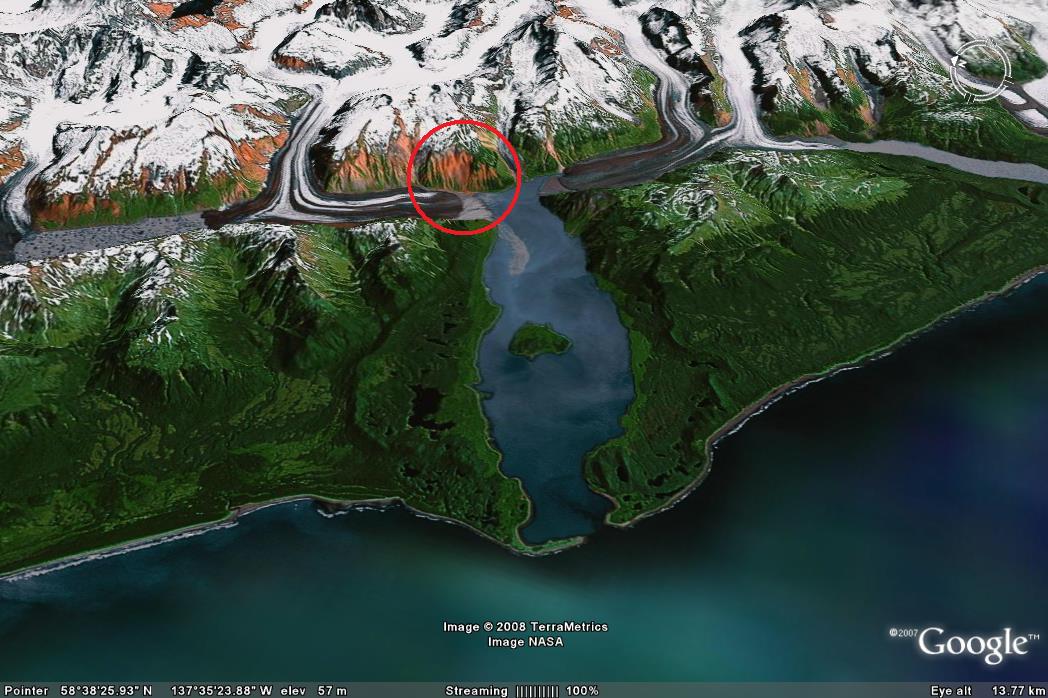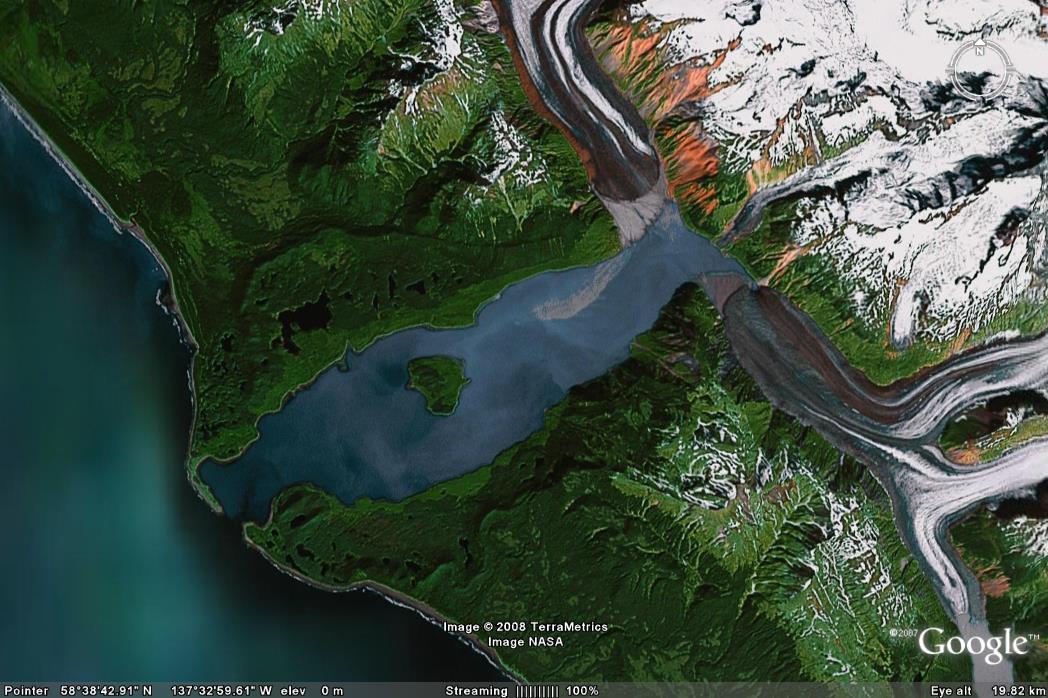9 July 2008
Lituya Bay – 50 years on
Posted by Dave Petley
Fifty years ago today, on the 9th July 1958, one of the most remarkable landslide events in recorded history occurred in Alaska. This was the Lituya Bay landslide, a large rockslide that collapsed catastrophically into a fjord in Alaska. Whilst the landslide itself was comparably unexceptional, though very large, the tsunami that it triggered most certainly was not.
Lituya Bay is located in the very southwest of Alaska (Figure 1). It consists of a narrow fjord some 12 km long and 2-3 km wide (Fig. 2). On the day in question at 10:16 pm, a magnitude 7.7 earthquake occurred on the Fairweather Fault about 21 km from Lituya Bay.
 Fig. 1: USGS map showing the location of Lituya Bay
Fig. 1: USGS map showing the location of Lituya BayThe earthquake triggered a collapse of a rockmass on a steep, recently debuttressed slope at the toe of the glacier at the top of the fjord (Fig. 3). The rockfall was large (probably about 40 million cubic metres) and catastrophic, falling as a single coherent mass into the fjord from a height of about 900 metres (fig. 4).
 Fig. 3: Google Earth perspective view of Lituya Bay, highlighting the location of the rockfall. Click on the image for a better view (opens in a new window).
Fig. 3: Google Earth perspective view of Lituya Bay, highlighting the location of the rockfall. Click on the image for a better view (opens in a new window). Fig. 4: USGS image showing the scar of the 1958 rockfall event
Fig. 4: USGS image showing the scar of the 1958 rockfall eventThe fall triggered a wave in the fjord that raced from the landslide to the mouth of the fjord. The descriptions of this wave are remarkable, but are quite well shown in Fig. 5. The wave had a maximum run-up height (this is the vertical distance that it ran up the valley wall) of 530 metres. Whilst this sounds extreme, there is clear evidence that this was the case from sediments left by the wave and from the removal of trees by the water. This is the highest coastal wave ever recorded, although this very high run-up zone might be considered to me more of a splash than a coherent wave. The wave then travelled the length of the fjord, probably at a speed of about 150 km/hour, removing trees from above the waterline as it went. This removal of trees can be very clearly seen in Fig. 4 and is shown in more detail in Fig. 5. Whilst the height of the wave declined rapidly as it travelled down the fjord, it was still over 30 m high when it reached the mouth of the bay.
 Fig. 4: USGS image showing the scar of the 1958 rockfall event
Fig. 4: USGS image showing the scar of the 1958 rockfall event Fig. 5: USGS image showing the removal of trees by the tsunami wave
Fig. 5: USGS image showing the removal of trees by the tsunami waveFortunately of course Lituya Bay is located in a remote and essentially unsettled part of Alaska. There were however three small boats in the bay at the time of the landslide, the Edrie, the Badger and the Sunmore. The Edrie was at anchor when the wave, at that point about 30 metres high, struck her. Fortunately she rode over the wave and did not sink. The Badger was carried over the spit at the entrance to the fjord (see Fig. 4) and deposited in the open ocean, whereupon she sank. Fortunately the crew survived. The Sunmore tried to outrun the wave but was caught by it and engulfed. The boat and her crew were lost.



 Dave Petley is the Vice-Chancellor of the University of Hull in the United Kingdom. His blog provides commentary and analysis of landslide events occurring worldwide, including the landslides themselves, latest research, and conferences and meetings.
Dave Petley is the Vice-Chancellor of the University of Hull in the United Kingdom. His blog provides commentary and analysis of landslide events occurring worldwide, including the landslides themselves, latest research, and conferences and meetings.
The 1958 Lituya Bay wave did not happen. The very steep Gilbert Spur was denuded by a landslide caused by the wet soil and forest shaking for a couple of minutes during the 7.9 earthquake.I spent five days this summer in Lituya Bay and saw no evidence of a 1720′ wave, but many points to indicate a slide.Keith Ware
Keith,I find that to be an astonishing and frankly bizarre claim. How can you explain:1. the eye witness accounts;2. the photographic imagery taken at the time;3. the evidence on modern satellite imagery.Take a look at the images here: http://geology.com/records/biggest-tsunami.shtmlHow can you explain for example the landsat image using the mechanism that you propose?
If there was no wave, then how did people lose their lives? Since the vegitation was ripped all throughout the inside of the bay, it seems like there was a wave.
Looks like the person who said that the wave did not happen is smoking something. There are personal accounts, Geology accounts, pictures and everything to support this. Of course I would have to say that this person, only spending 5 days in a place and looking around after 50 years has gone by without actually doing some investigating indicates he doesn't know what he is talking about. Mr anonymous, why were you there for 5 days? What were you doing? Were you looking into what happened? I am guessing you spent most of that time drinking and goofing off rather then being there on a scientific expidition.
These articles are fantastic; the information you show us is interesting for everybody and is really good written. It’s just great!! Do you want to know something more? Read it…: Great investment opportunity in Costa Rica
[…] failures have a well documented track record of generating truly enormous local tsunami, with the Lituya Bay event in 1958 being the archetype of course. But, as I highlighted earlier this week, the behaviour of large […]
[…] Bay, releasing an estimated 40 million cubic yards (30 million cubic meters) of material. The ensuing splash reached more than 1,700 feet (530 meters) in height. A gigantic wave then rolled through the fjord, […]
[…] Bay, releasing an estimated 40 million cubic yards (30 million cubic meters) of material. The ensuing splash reached more than 1,700 feet (530 meters) in height. A gigantic wave then rolled through the fjord, […]
[…] Bay, releasing an estimated 40 million cubic yards (30 million cubic meters) of material. The ensuing splash reached more than 1,700 feet (530 meters) in height. A gigantic wave then rolled through the […]
[…] Lituya Bay, releasing an estimated 40 million cubic yards (30 million cubic meters) of fabric. The ensuing splash reached greater than 1,700 ft (530 meters) in peak. A huge wave then rolled by way of the fjord, […]
[…] क्यूबिक मीटर) सामग्री जारी हुई। आगामी छप 1,700 फीट (530 मीटर) से अधिक तक पहुंच गया) […]
[…] Bay, releasing an estimated 40 million cubic yards (30 million cubic meters) of material. The ensuing splash reached more than 1,700 feet (530 meters) in height. A gigantic wave then rolled through the fjord, […]
[…] Bay, releasing an estimated 40 million cubic yards (30 million cubic meters) of material. The ensuing splash reached more than 1,700 feet (530 meters) in height. A gigantic wave then rolled through the fjord, […]
I recall a NOVA(?) presentation suggesting that the wave was larger than expected w/a slide mass of that size because it entrained a large pocket of air as it entered the water.
[…] Bay, releasing an estimated 40 million cubic yards (30 million cubic meters) of material. The ensuing splash reached more than 1,700 feet (530 meters) in height. A gigantic wave then rolled through the fjord, […]
[…] de terra na Baía de Lituya, liberando cerca de 30 milhões de metros cúbicos de material. O onda resultante atingiu mais de 530 metros de altura, que rolou pelo fiorde, derrubando árvores e matando cinco […]
[…] de terra na Baía de Lituya, liberando cerca de 30 milhões de metros cúbicos de material. O onda resultante atingiu mais de 530 metros de altura, que rolou pelo fiorde, derrubando árvores e matando cinco […]
[…] de terra na Baía de Lituya, liberando cerca de 30 milhões de metros cúbicos de material. A onda resultante atingiu mais de 530 metros de altura, que rolou pelo fiorde, derrubando árvores e matando cinco […]
[…] Bay, releasing an estimated 40 million cubic yards (30 million cubic meters) of material. The ensuing splash reached more than 1,700 feet (530 meters) in height. A gigantic wave then rolled through the fjord, […]
[…] de terra na Baía de Lituya, liberando cerca de 30 milhões de metros cúbicos de material. A onda resultante atingiu mais de 530 metros de altura, que rolou pelo fiorde, derrubando árvores e matando cinco […]
[…] releasing an estimated 40 million cubic yards (30 million cubic meters) of enviornment topic. The ensuing splash reached bigger than 1,700 toes (530 meters) in top. A tall wave then rolled through the fjord, […]
[…] Lituya Bay, releasing an estimated 40 million cubic yards (30 million cubic meters) of fabric. The ensuing splash reached greater than 1,700 toes (530 meters) in peak. A huge wave then rolled by way of the fjord, […]
[…] Bay, releasing an estimated 40 million cubic yards (30 million cubic meters) of material. The ensuing splash reached more than 1,700 feet (530 meters) in height. A gigantic wave then rolled through the fjord, […]
[…] Bay, releasing an estimated 40 million cubic yards (30 million cubic meters) of material. The ensuing splash reached more than 1,700 feet (530 meters) in height. A gigantic wave then rolled through the fjord, […]
Meanwhile, at the head of Lituya Bay:
https://www.alaskapublic.org/2020/10/26/mother-of-all-jokulhlaups-reported-in-southeast-alaska/